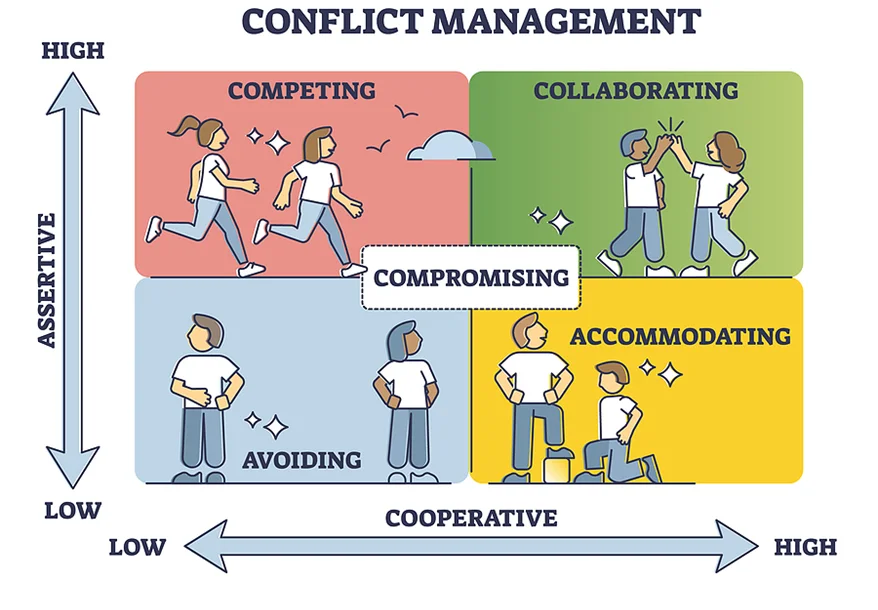The Thomas-Kilmann Conflict Modes
The Thomas-Kilmann Conflict Mode Instrument (TKI) is a model designed to help individuals understand their own conflict resolution styles and navigate interpersonal conflicts more effectively. Developed by psychologists Kenneth Thomas and Ralph Kilmann in the 1970s, the model outlines five primary conflict resolution styles, each reflecting a combination of assertiveness (the extent to which a person pursues their own interests) and cooperativeness (the extent to which a person seeks to satisfy the other party's interests).

The five conflict resolution styles in the Thomas-Kilmann Model are:
- Competing (High assertiveness, Low cooperativeness) - This style is characterized by a desire to win at all costs, prioritizing personal interests over others'. It may involve aggressive behavior and the use of authority or power to resolve conflicts. This style can be effective in situations where a quick decision is necessary, but can damage relationships if used excessively.
- Accommodating (Low assertiveness, High cooperativeness) - This style involves prioritizing the needs and interests of others over one's own. Individuals who use this style often yield to others' demands to maintain harmony and avoid conflicts. While accommodating can be helpful in preserving relationships, it may lead to resentment if one's needs are continually overlooked.
- Avoiding (Low assertiveness, Low cooperativeness) - This style involves evading or ignoring conflicts altogether, with individuals neither pursuing their own interests nor addressing the interests of others. While avoiding may be a short-term solution in certain situations, it may lead to unresolved conflicts and increased tension over time.
- Compromising (Moderate assertiveness, Moderate cooperativeness) - This style seeks to find a middle ground where both parties give up something to reach a mutually acceptable solution. Compromise may be beneficial in situations where a quick resolution is needed, but can result in suboptimal outcomes if important needs or values are sacrificed.
- Collaborating (High assertiveness, High cooperativeness) - This style aims to find a win-win solution by addressing the needs and interests of all parties involved. Collaborating involves open communication, empathy, and creative problem-solving to develop a solution that satisfies everyone. While this approach is often the most effective for long-term conflict resolution, it can be time-consuming and may not be suitable for all situations.
Understanding these conflict resolution styles can help individuals become more aware of their own tendencies and adapt their approach to better manage conflicts in various personal and professional contexts.
Example
Let's imagine a scenario in a workplace where two employees, John and Jane, have been assigned to work together on a project. However, they have a disagreement about the direction of the project. John believes they should focus on creating an innovative new product, while Jane thinks they should improve an existing product.
- Competing: John, taking a competitive approach, insists on following his idea and disregards Jane's opinion, using his seniority to push his agenda. He tells Jane that they will proceed with his plan because he has more experience in the industry.
- Accommodating: Instead of advocating for her idea, Jane decides to prioritize harmony in the team and agrees to go along with John's plan, even though she feels strongly about her own suggestion.
- Avoiding: Both John and Jane avoid discussing their differing opinions on the project, instead focusing on unrelated tasks and postponing the inevitable conflict. The project's progress stalls, and the unresolved disagreement may lead to frustration and resentment over time.
- Compromising: John and Jane agree to meet halfway, deciding to incorporate some innovative features into the existing product. While this decision addresses both of their concerns to some extent, it may not be the optimal solution for the project, as it may not fully satisfy the objectives of either party.
- Collaborating: John and Jane engage in an open discussion about their differing opinions and actively listen to each other's perspectives. They brainstorm possible solutions and ultimately come up with a plan that combines their ideas in a way that satisfies both of their goals. This approach fosters trust and strengthens their working relationship.
These examples illustrate how the different conflict resolution styles from the Thomas-Kilmann Model can play out in a workplace setting, with varying degrees of effectiveness depending on the situation and the individuals involved.
Video
Founder
Related Topics
The Thomas-Kilmann Conflict Modes 0 reviews
Login to Write Your ReviewThere are no reviews yet.


